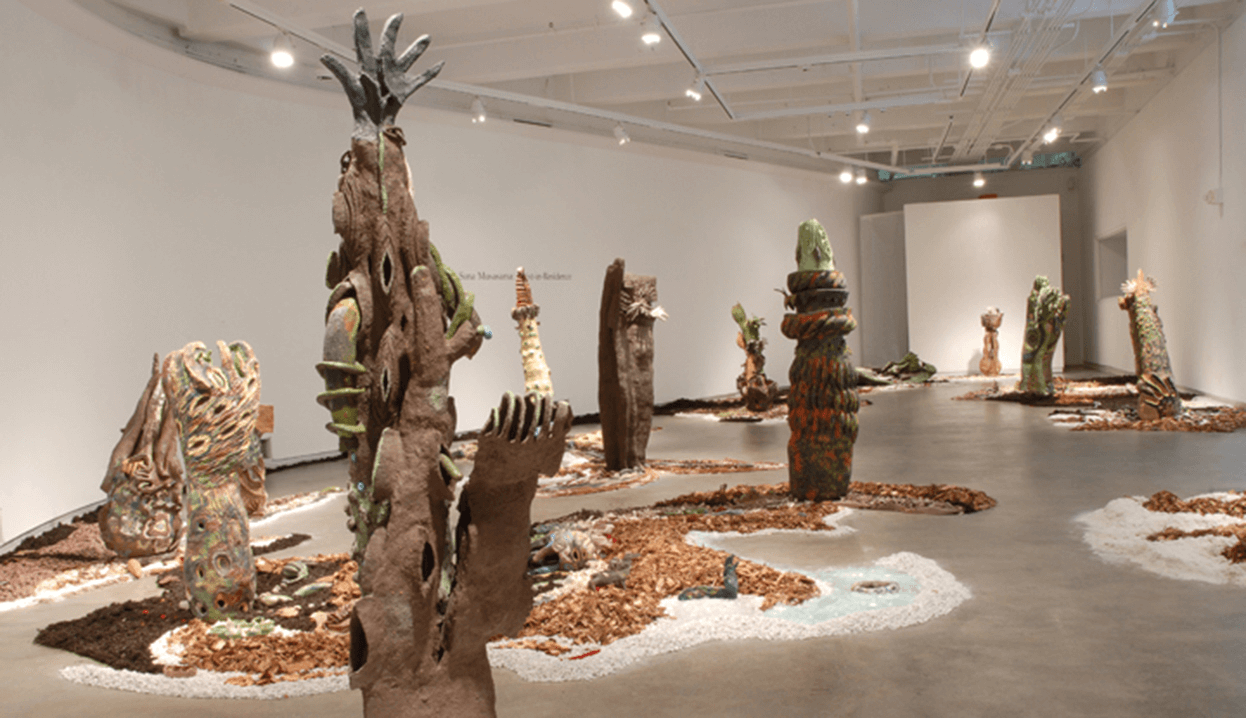
Sana Musasama, Ceramics
The Anya and Andrew Shiva Gallery at John Jay College has hosted dozens of exhibitions since it opened in 2013. Making works by faculty and student artists as well as well-known external artists accessible to students and community alike, the shows have encompassed a variety of media and focus on a constellation of justice-related issues that define John Jay’s mission.
To continue hosting exhibitions during the pandemic, the Shiva Gallery has been forced to adapt. Its 4,000 square-foot space received a virtual expansion courtesy of a customizable platform that has allowed curator, art historian and John Jay Professor Thalia Vrachopoulos to continue putting together collections that interrogate issues of justice through the eyes of artists.
In the past, shows have tackled subjects as varied as women in the prison system, sustainability, and physically transforming racist books into multi-media artworks. Vrachopoulos’s first virtual exhibition, which opened in 2020, was Polycentric, Dialogical and Relational, a show comprised of artworks created by John Jay faculty. They vary by theme and medium, indicative of how impressed Vrachopoulos was by the breadth and depth of John Jay faculty members’ specialties and their viewpoints, which she calls a representation of our own inclusive climate.
One featured artist was Sana Musasama; an adjunct in the Department of Art and Music, Musasama’s mixed media work often communicates the stories she has experienced as a woman and a world traveler. “My study of ceramics would bring me to really remote places,” she says, “and I would see things that were different, things that made me wince, things that made me cry. I wrote about them, I studied them, I questioned them, I made an opinion about them, and then I started to make art about them and tell them to people who that would never happen to.”
As a consequence, Musasama has produced art that investigates hard subjects like female genital cutting, foot binding, child marriage or girl soldiers—stories that touch her as she moves through female spaces in the world. Each year for the past 14 years, she has returned to Together One Heart in Cambodia to teach crafting to young women recently rescued from unwilling participation in the sex trade. For the past eight years, Musasama has run a business with some of these women, creating fabric products like aprons and bags from vibrant mixed textiles that she sells in the U.S. “This is their extra income,” she says. “It is the income that keeps them safe.”
The pieces Musasama contributed to Polycentric were originally part of a series on trees that she put on at Dartmouth College, which eventually became part of the permanent collection at Dartmouth’s Hood Museum. With beautiful mixed media that evoke the snowy forests of New Hampshire, the installation had a different feeling when presented virtually. Divorced from their installation-specific context, and standing in an empty virtual “space,” the sculptures give free reign to the imagination, like something one might find on another planet.
As the United States moves toward post-COVID life, some things will change, and others stay the same. Musasama is looking for new joy after a season of grief and creative stagnation. “The work I’ve produced the last 30 years is basically work that hurts,” she says. “Now with the pandemic, I want to make work that makes me smile.” Her new project is creating two-headed Topsy-Turvy dolls, each of which depicts two different women that inspire her.
And Vrachopoulos, once COVID is behind us, hopes for a quick return to the gallery space, which she describes as a necessity for exposing students to the physical experience of art, something she values highly. But she isn’t ruling out hanging onto a virtual space even when campus has reopened. “It gives us a much broader scope—we don’t necessarily have to have the same show in the gallery as we do in the virtual exhibition,” she says, “and the students can have a much broader exposure. Plus you can reach a wider audience.”
